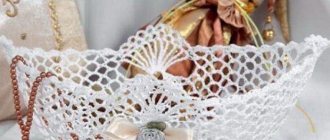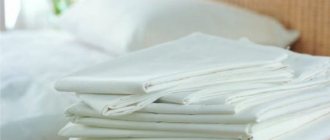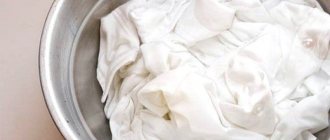To give clothes elegance and shine, sometimes you need to remember old methods. One of them is the application of starch to fabric. Skirts, shirts and underwear are rarely treated in this way today, so few people know how to do it. How to starch a skirt at home correctly?
When starch comes into contact with clothing, it forms a film that gives the item shape and volume. Doctors recommend starching your underwear to prevent it from becoming damp and absorbing harmful bacteria.
To process skirts, you can purchase special products in the store. There are compositions that can simply be sprayed onto a fabric or added to water. But you can prepare the solution at home yourself; any type of starch will do. Each type of fabric has its own method and dosage.
What proportions of starch are needed to starch a skirt?
You can prepare the solution at home yourself. Both potato starch and rice or corn starch are suitable for this. The proportions will depend on how hard you want it to be. If you just need to strengthen the bottom cover a little, starch is taken at the rate of 5 grams per 1 liter of water. For stronger support, it is necessary to prepare a concentrated solution in this way:
- dilute a tablespoon of starch in a glass of water at room temperature;
- pour the resulting solution into 0.5 liters of boiling water, stirring thoroughly so that there are no lumps;
- keep the solution on the fire for about 5 minutes;
- Strain the resulting liquid.
The finished composition is poured into a bowl of cold water.
What means are suitable
Is it possible to starch tulle with food starch? This is a really good method, but sustainable results when processing fabric made from polyester thread can be achieved precisely by using ready-made household products. In some cases, it is much easier to shape an elegant skirt using a spray or aerosol. You can process the product for fullness directly on the person, straightening the layers to your liking. It is important that with some ready-made products you can add firmness to clothes made from dark fabrics without fear of encountering stains.
Table 2. By what means can you starch a skirt?
| Product name | Detailed Specifications |
| Selena | A universal liquid product for starching all types of fabric. Suitable for manual and machine care. |
| Kotiko | Starch for all types of material, sold in 1 liter bottles. This amount is enough for 20 washes. |
| Chirton | Starch in the form of an aerosol greatly simplifies the starching process. The product is applied to the product and then fixed with a warm iron. |
| Frau Schmidt | A liquid product based on natural potato starch that makes washing and ironing easier. |
How to starch a tulle skirt
Please note that only the lower layers of the skirt need to be starched; the upper layers should not touch the composition.
The easiest way to starch a tulle skirt at home is by yourself. But there is a small nuance in this process: skirts made of this material consist of many layers. They do not need to be starched completely, otherwise they will turn out to be very large, and this will harm the appearance of the item. Only the lower layers need to be starched; the upper ones should not touch the composition.
Which fabrics are suitable for starching and which are not?
You can starch almost any type of skirt fabric. But will this make sense?
Starch will work great on the following skirts:
- Fatinov;
- Mesh;
- Cotton;
- Satin;
- Linen;
- Ballet tutus.
But, for example, synthetic, silk, chiffon skirts simply do not need to be starched, because they will not hold volume and shape under any circumstances, that is, you will not see the desired effect on them, but will only waste time and effort.
You should not starch things of black, dark blue, dark green and other similar colors: there is a high probability of white spots and streaks appearing on them.
How to starch a mesh skirt
To starch a mesh skirt you will need 2 tablespoons of starch.
To give shape to mesh clothing, you need to dilute 2 tablespoons of the substance in a glass of water. The solution is mixed well, this is necessary to avoid the formation of lumps, then the resulting composition is poured into a liter of boiling water. The cooled mixture is filtered through cheesecloth, and the item is briefly dipped into the resulting solution. After this, it must be squeezed out well, but not twisted, as it will be difficult to smooth out the folds later.
The mesh skirt is dried with an iron. You need to iron it until it is completely dry.
How to prepare fabric for starching?
Before starching, the skirt should be thoroughly washed and dried thoroughly. Even if it was in the closet and no one wore it for years, the thing still requires cleaning from dust.
Preparing the item is simple: wash, dry, remove grease stains, if any
Grease stains also need to be removed, otherwise the starch solution will become their litmus test: previously practically invisible, after treatment with the solution they will acquire an unpleasant yellowish color and will be visible even from afar, and it will be almost impossible to get rid of them.
Grease stains can be easily removed with dishwashing detergent. It is also advisable to get rid of pellets on the fabric. To do this, you can use a special machine, razor, tweezers, and even crusts of bread! There are a lot of alternative options.
Before starching a skirt, it is better to remove all decorations and design elements from it: belts, ruffles, brooches, and so on. Also, after washing, the skirt should be carefully ironed, getting rid of all wrinkles and dents.
Next, we’ll look at how to starch a skirt at home step by step.
How to starch a child's skirt
A children's party always requires special preparation. To give a beautiful, fluffy shape to a children's dress for an important event, you need to do the following:
- dilute 4 tablespoons of starch in a glass of water;
- pour into a saucepan with 2 liters of boiling water;
- if lumps have formed in the solution, you need to strain the composition through gauze;
- pour the resulting mixture into a basin and rinse the product in it;
- After this, do not twist the skirt, but slightly squeeze it out;
- Iron the product until completely dry.
You can dry the item a little before ironing by laying it on a flat surface.
Procedure for the starching process
With almost all types of fabrics, the starching process occurs as follows:
- We select a large container into which the entire skirt can easily fit, fill it with cold water and dilute the pre-prepared starch paste in it;
- We place the skirt in the solution so that its entire surface is immersed in the liquid and has the opportunity to be completely saturated with the mixture (for this it is recommended to rinse the item in the liquid);
- We take the skirt out of the solution, barely wring it out, and lay it out on a clean, large horizontal surface or hang it on a hanger;
- During the drying process, lightly give it the shape we want and let the skirt dry;
- After drying, go over the fabric with an iron.
How to starch a “tutu” skirt at home
After starching, the “pack” cannot be twisted or squeezed.
The tutu skirt should be tight. To do this, it must be completely immersed in the starch solution, and after the procedure is completed, carefully remove it. You cannot squeeze or twist the skirt. The fabric should dry a little, but not completely, because the item is ironed a little damp.
If you want the pack to not be too rigid, you can soak only the lower layers with the solution without touching the top. Then you will get volume, visual lightness and softness of the product.
Tips for special occasions
As a rule, there are no problems with starching home textiles, bedding sets and everyday clothes. But which way to approach the bride’s snow-white outfit and how not to spoil the child’s Snowflake costume? Consider a few recommendations for such special cases.
Wedding Dress. You don’t have to touch the top if it is made of a corset without puff sleeves. And to starch a fluffy skirt with starch, in this case you will need a hard solution. Do not wait for the fabric to dry, and immediately iron it (through gauze). Moreover, you can starch a dress for a celebration with varying degrees of pomp. If you don’t want a clear “ballroom” effect, then treat not all the petticoats, but every other one.
Children's New Year's dress. If you are wondering how to starch the petticoat of a child's dress, proceed by analogy with a wedding dress
However, pay attention to the elements at the top of the product (ruffles, bows, flounces). They quickly lose their appearance and also need to be treated with paste.
Here you can act spot-on or soak the entire suit in the solution.
Cuffs and collars. A hard solution is also used to starch cuffs and collars. To make it work even better, add sodium boric salt. A tablespoon of the product must be dissolved in 200 ml of boiling water. However, the solution must be allowed to sit for at least two hours. Dip into the paste only those elements that need processing.
Starch a satin skirt
Adding 1/2 teaspoon of salt to the starch solution will give the skirt a glossy shine.
Satin clothes are the most difficult to starch due to the density of the material. We prepare the solution from 2 tablespoons of starch and a glass of water, then dilute the composition in a liter of boiling water. Pour the resulting mixture into a bowl of water at room temperature and completely lower the skirt there. It should lie in the starch for 15–20 minutes.
After the procedure, dry the item on a hanger, then iron it with an iron and steam.
All things can be starched; they become more durable and less susceptible to contamination. If you use our grandmothers' secret and add 1/2 teaspoon of salt to the solution, you can give things a glossy shine.
Subtleties
How to starch a tulle skirt? Despite the fact that the algorithm of actions is the same in almost all cases, when working with different types of fabric, the following nuances must be taken into account:
When working with skirts made of tulle and mesh: you need to starch only the lower layers of the skirt, without touching the very top ones, and before leaving the skirt to dry, you need to make sure that there are no unsightly creases or kinks on the fabric.
When working with cotton skirts: it is very important to remember that cotton itself has excellent absorbent properties, and that is why it is still not recommended to immerse it entirely in liquid. Treating the fabric in two or three layers using a sponge or sprayer will be most suitable and effective.
When working with a satin skirt: this material is the most problematic when starching. When processing it, it is better to prepare a solution according to the proportions for maximum hardness. Unlike cotton, satin absorbs liquid poorly, so the skirt must be completely immersed in liquid and left for 15-20 minutes. The main problem with satin fabric when starched is the loss of the fabric's original shine and gloss upon contact with starch. That is why many housewives prefer to use alternative methods: treatment with gelatin or sugar solution.
How to starch a linen skirt: linen wrinkles and creases very easily without much effort. Therefore, when processing and drying, you should especially pay attention to the appearance of the fabric and periodically correct it.
After treatment with starch, the skirt must be left to dry at room temperature. Do not place the item of clothing in direct sunlight or attempt to dry it with a hairdryer. Excess starch will come out of the fabric spontaneously. You can iron either slightly damp or completely dry fabric. The iron needs to be passed along the wrong side of the skirt.
This way, there will be no problems with unpleasant white streaks and stains on things.
Step-by-step instruction
- Prepare starch milk. If necessary, you can increase the amount of powder and liquid, strictly maintaining the proportions.
- Completely immerse the item in the solution and wait 6 minutes.
- Before removing the product from the solution, you must carefully inspect it and make sure there are no dry areas.
- Remove the skirt from the starch milk, carefully straighten all the folds and allow excess liquid to drain.
- Leave the item to dry in a vertical position (for example, on a hanger).
- When the product is almost dry, it is recommended to iron it with a not very hot iron. At the same time, it is strictly forbidden to moisten or steam the fabric! A starched item only needs dry heat, because water destroys the thin “crust” formed on the surface.
Details
How to prepare starch for starching
To prepare the starch solution, no special ingredients are needed. All you need is water and starch (ideally potato starch). The proportions of starch for starching depend on the degree of hardness you want to achieve on a particular product. And there can be three of them:
- Minimal - used for light fabrics such as chiffon. To do this, you need to dissolve 1-2 tsp in 1 liter of water. starch.
- Medium - used for linen and cotton. To do this, you need to dissolve 3 tsp in 1 liter of water. starch.
- Maximum - used for the hardest and densest fabrics. To do this, you need to dissolve 4-6 tsp in 1 liter of water. starch.
After adding starch to the water, it must be brought to a boil, stirring constantly to prevent lumps from appearing. After this, you need to leave the solution to cool to room temperature.
REFERENCE! To get the best effect, strain the prepared solution through a fine sieve or gauze cloth.
Preparing fabric for starching
Before carrying out the procedure, you must wash the skirt well and then dry it thoroughly. Even if it was in the closet before and seems clean, it still needs to be cleaned of dust by washing it.
If there are greasy stains on the product, then you must remove it, otherwise the starch solution will become a litmus test for them. This means that previously unnoticeable stains after treatment with starch will receive an unpleasant yellowish tint and will be noticeable from afar. After this, it will be almost impossible to get rid of them.
Dishwashing liquid does an excellent job of removing grease stains. In addition, it is worth removing pellets from the fabric, if any. This can be done with a special machine, tweezers, a razor, and even a crust of bread. There are many options.
REFERENCE! Before carrying out the starching procedure, you should remove all design elements and decorations from the skirt (belts, brooches, ruffles, etc. In addition, after washing, you must carefully iron the skirt to remove all bruises and folds.
Below are the steps for starching skirts at home.
How to starch a skirt with starch
Almost all types of fabrics are starched by following these steps:
- We take a container suitable in size so that the entire skirt can easily fit in it, and fill it with cold water. Now you need to dissolve the pre-prepared starch paste in it.
- Place the skirt in the solution so that it is completely covered with the solution. The skirt should be completely saturated with the mixture. To do this, it is often recommended to rinse the product in a starch solution.
- We take the skirt out of the mixture and, almost without squeezing, lay it out on a clean horizontal surface. Or you can hang the skirt on a hanger.
- While drying, you should lightly shape the skirt into the shape you want. The product must be left until completely dry.
- When the skirt is dry, iron over the fabric.
Subtleties
The procedure is practically the same for any fabric. But there are some nuances in working with different fabrics.
How to starch a tulle skirt
When working with skirts made from these fabrics, you should starch only the lower layers, without touching the upper ones. Also, before hanging your skirt to dry, you should make sure that there are no unsightly kinks or creases on it.
Cotton
Cotton is distinguished by its absorbent properties and it is better to remember this. Do not completely immerse it in the solution. It is better to treat the fabric with the solution using a sponge or sprayer in several layers. This will be more effective and appropriate.
Atlas
This fabric is the most problematic when starching. When processing it, you should make a solution of maximum hardness. Satin, on the contrary, does not absorb liquid well, so a skirt made of such fabric should be completely immersed in the solution and left there for 15-20 minutes. The main difficulty when starching satin fabrics is that they lose their original gloss and shine when in contact with starch.
REFERENCE! For this reason, many housewives use other methods for satin, for example, sugar solution or gelatin.
Linen
This fabric creases and wrinkles without much effort. Therefore, during processing and drying, it is necessary to pay attention to the product, adjusting it from time to time.
After starch treatment, the skirt should be left to dry at room temperature. You cannot take the item outside, into the sun or dry it with a hairdryer. Excess starch will come out of the fabric on its own.
You can iron the fabric completely dry or slightly damp. You need to iron the skirt from the wrong side.
REFERENCE! If you follow all the tips, you will be able to avoid problems with stains or unpleasant white streaks on things.
For what purpose are things treated with starch?
Half a century ago, housewives tried to starch almost all the things in the house made from natural fabrics. Most of all, table linen, bed linen, napkins, collars, cuffs, men's shirts, panama hats and curtains suffered the most. This was done for several reasons at once, because starched things:
- retain their attractiveness and purity longer;
- wrinkle less;
- last longer;
- gain additional strength;
- bleach over time.
Now, individual wardrobe items, skirts, hats, and furniture covers are subjected to this procedure. A starched item is able to retain its shape, which is extremely necessary for individual products. Also, there may be a “production necessity” in carrying out the starching procedure. A striking example of this is the tutu of ballerinas, who keep their shape despite complex pirouettes and steps.
Dermatologists do not recommend starching bed linen, as this reduces the breathability of the fabric. This may lead to skin irritation.
Product for starching things
Starch Luxus Superforma, 400 ml
A product whose use allows you to starch and give shape to even dry laundry. Starch can be used on white or colored fabrics. After application, the drug does not form an airtight film. Purpose of application: maintaining the shape of the product and preventing the appearance of contamination on the surface.
Fabric starch Sano Iron Easy, 700 ml
A spray used to care for clothes and give them a more presentable appearance. This drug is best used during ironing. Before carrying out the procedure, you need to lightly spray the laundry with a solution containing silicone, fragrance and starch. After ironing, the fabric becomes smoother and the item acquires a pleasant aroma.
G&G Spruh Starke laundry starch, 500ml
The drug can be used on any fabric, with the exception of silk. The purpose of its use is to starch laundry, which is done when ironing it. The product is ideal for ironing dry laundry. In this case, you can refuse additional options that are available in any modern iron. To iron your laundry, you must first spray it with an aerosol.
Methods without starch
Textiles can be shaped without starch. Processing methods:
- Sugar. Boil 1 liter of water with 6 tablespoons of sugar. Dip the fabric into the hot liquid. After it is soaked, take it out and squeeze it out. Sweet textiles can attract insects.
- PVA glue. Combine glue and warm water in a ratio of 1:1 (hard method) or 1:2 (soft method). Soak the product in the solution, squeeze and dry. This method is convenient for processing small things that do not come into contact with the body.
- Gelatin. Pour one tablespoon of gelatin into 50 ml of cold water. After it swells, heat it in a water bath and pour in another 200 ml of water. When the gelatin is completely dissolved, immerse the product in it for a few seconds. This method is suitable for voluminous knitted items, as well as artificial flowers and other similar decor. It is convenient to lubricate small parts with the solution using a brush.
- Silicate glue. Dilute 1 teaspoon of glue in 5 liters of water. Dip the item into the solution for a few minutes, wring it out, and dry it. The method is suitable for silk and other delicate fabrics.
Other methods
To starch a dress, you don't have to do it by hand. You can use a washing machine by pouring the solution into the conditioner compartment and turning on the normal wash cycle. You can also purchase ready-made products with starch for use in automatic washing. They can be in powder or conditioner form.
You can use a washing machine to starch things
The DIY solution may remain inside the washing machine. In order not to spoil things during the next wash, you need to remove the clothes treated with starch, close the machine and turn on the rinse mode. Once completed, you need to wipe the inside of the drum.
In household chemical stores you can purchase a special spray that is convenient to use to quickly make individual items of clothing lush and beautiful. This product will be indispensable for dresses decorated with embroidery. Decor that cannot be treated with starch is covered with film and then sprayed with a spray. You can starch a dress quickly and accurately by pouring liquid you prepared yourself into a spray bottle.
In stores you can purchase a special spray that is convenient to use to quickly make individual items of clothing fluffy/hard
Try starching a dress once, and you will understand how easy it is to make clothes especially beautiful without the help of specialists.
How to dry and iron
When dried, starch crystals remain in the fibers. The skirt acquires greater hardness than before starching. To prevent the product from becoming deformed, it is worth considering the following recommendations:
- Spin.
You are allowed to squeeze the skirt a little to get rid of excess water. Twisting and squeezing dry is unacceptable. - Drying position. The product is dried on a hanger with clips or hangers. As a standard, you need to put the skirt on the mannequin. The item should be straightened so that the hem has a fluffy shape.
- Drying decorative elements. To prevent ribbons, patterns and other parts from deteriorating, it is worth straightening and securing them. The patterns are pinned to a smooth surface, the fringe is combed with a sparse comb.
- Drying without heating devices or hair dryer.
They cannot be used.You need to dry the skirt naturally at room temperature. Do not dry it outside or on the balcony in winter.
- Wet /strong>. It is necessary to iron while the starched skirt is still wet. If it is dry, you should use a sprayer to moisten it or place a dampened rag on top.
- Iron temperature. It is not necessary to set a higher temperature and use steam. Depending on the thickness, medium or low heat will be needed.
Proportions
The use of starch allows you to regulate the “degree of hardness” of the processed product. However, the type of fabric also matters. The table provides information that will help you determine the dosage of starch (per liter of water).
| Rigidity | Name of fabric or product | Starch, tsp. |
| Minor | Tulle, chiffon, silk | 0,5-1,5 |
| Soft | Gauze, cambric, cotton tulle | 1,5-2 |
| Average | Linen, cotton | 2-3 |
| High | Decorative jewelry, tutus, gauze petticoats | 3-6 |











